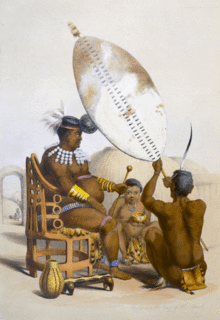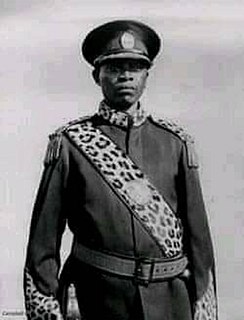
Mpande kaSenzangakhona was monarch of the Zulu Kingdom from 1840 to 1872. He was a half-brother of Sigujana, Shaka and Dingane, who preceded him as Zulu kings. He came to power after he had overthrown Dingane in 1840.

Cetshwayo kaMpande was the king of the Zulu Kingdom from 1873 to 1879 and its leader during the Anglo-Zulu War of 1879. His name has been transliterated as Cetawayo, Cetewayo, Cetywajo and Ketchwayo. Cetshwayo consistently opposed the war and sought fruitlessly to make peace with the British, and was defeated and exiled following the Zulu defeat in the war. He was later allowed to return to Zululand, where he died in 1884.

Nkayishana Maphumzana 'Phumuzuzulu' Solomon kaDinuzulu (1891–1933) was the king of the Zulu nation from 1913 until his death on 4 March 1933 at Kambi at the age of 41 or 42. He was born on the island of St. Helena during the exile there of his father, king Dinuzulu kaCetshwayo.
Senzangakhona kaJama was a chief of the Zulu clan, and primarily notable as the father of three Zulu kings who ruled during the period when the Zulus achieved prominence, led by his oldest son Shaka.
Jama kaNdaba, the son of Ndaba kaMageba, was a High Chief of the Zulu clan from 1763 to 1781. His grandfather was Chief Mageba kaGumede.

Zibhebhu kaMaphitha Zulu (1841–1904) was a Zulu chief. After the defeat of the Zulu Kingdom by the British, he attempted to create his own independent kingdom. From 1883 to 1884, he fought the Zulu king Cetshwayo, inflicting a series of defeats on him.
Mhlangana was a Zulu prince - the son of Senzangakhona, a brother of Shaka, and half-brother of Dingane and Mpande. He assisted Dingane and Shaka's induna (advisor) Mbopha in Shaka's assassination at Dukuza in 1828, and was himself assassinated by Dingane shortly afterwards.

Nongoma is a town in Zululand, KwaZulu-Natal, South Africa. It is the seat of the Nongoma Local Municipality. It is situated 300 km north of Durban and 56 km from Ulundi; it is surrounded by the Ngome Forest. It is a busy market town that serves a large surrounding area. It is assigned registration plate NND.
Ndlela kaSompisi was a key general to Zulu Kings Shaka and Dingane. He rose to prominence as a highly effective warrior under Shaka. Dingane appointed him as his inDuna, or chief advisor. He was also the principal commander of Dingane's armies. However, Ndlela's failure to defeat the Boers under Andries Pretorius and a rebellion against Dingane led to his execution.This made him a failure in the eyes of his people.
The Zulu royal family consists of the late king of the Zulus, Goodwill Zwelithini kaBhekuzulu, his consorts, and legitimate descendants.

Sigananda kaZokufa was a Zulu aristocrat whose life spanned the reigns of four Zulu kings in southeastern Africa. In an address by Mangosuthu Buthelezi at Endlamadoda-Nkandla on 15 September 2001 he said that Inkosi Sigananda's grandfather was Inkosi Mvakela, who married a sister of Nandi, King Shaka's mother, and that his father was Inkosi Zokufa. He also said he had a son called Ndabaningi. At this occasion he unveiled a monument to Inkosi Sigananda.

The Zulu Kingdom, sometimes referred to as the Zulu Empire or the Kingdom of Zululand, was a monarchy in Southern Africa that extended along the coast of the Indian Ocean from the Tugela River in the south to Pongola River in the north.

The Battle of Ndondakusuka was the culmination of a succession struggle in the Zulu Kingdom between Cetshwayo and Mbuyazi, the two eldest sons of the king Mpande, often known as the Second Zulu Civil War. Mbuyazi was defeated at the battle and was killed, leaving Cetshwayo in de facto control of the kingdom, though his father remained king. Mbuyazi's followers were massacred in the aftermath of the battle, including five other sons of King Mpande.
Nongalaza KaNondela was a Zulu warrior who was the principal military commander of King Mpande of the Zulu kingdom.
Sigujana kaSezangakhona was chief of the Zulu people in 1816. He was the son of Senzangakhona kaJama and half-brother of Dingane kaSenzangakhona and Shaka kaSenzangakhona. He succeeded his father c. 1816. His mother was Bhibhi kaSompisi. Shortly after he became chief, he was eliminated by his half-brother, Shaka. It is disputed on whether Shaka had him assassinated, or Shaka himself killed Sigujana by stabbing him. His birth date is unknown, but whatever the case, he died in 1816, shortly after he had become chief.
The National Heritage Monument is a group of copper statues representing anti-apartheid activists, Zulu chiefs and missionaries. The monument is meant to reflect the struggle for liberation going back into the 1600s. It is located in Groenkloof Nature Reserve. The project was started in 2010, but as of 2015, only has 55 statues. A total of 400 to 500 statues are planned. When complete, the monument will be called "The Long Walk to Freedom."
Princess Mkabayi kaJama was founder and the head of the Qulusi military kraal and Regent of the Zulu. She persuaded her father, the Zulu king Jama kaNdaba, to remarry, and acted as a regent to her ensuing half-brother, Senzangakhona. She was a kingmaker for three succeeding reigns, leading coups and arranging assassinations. She is credited for bringing stability in the Zulu nation and ensuring the continuation of the Zulu line and monarchy.
uHamu kaNzibe or Hamu kaNzibe was a Zulu chieftain, half-brother and great rival of king Cetshwayo.